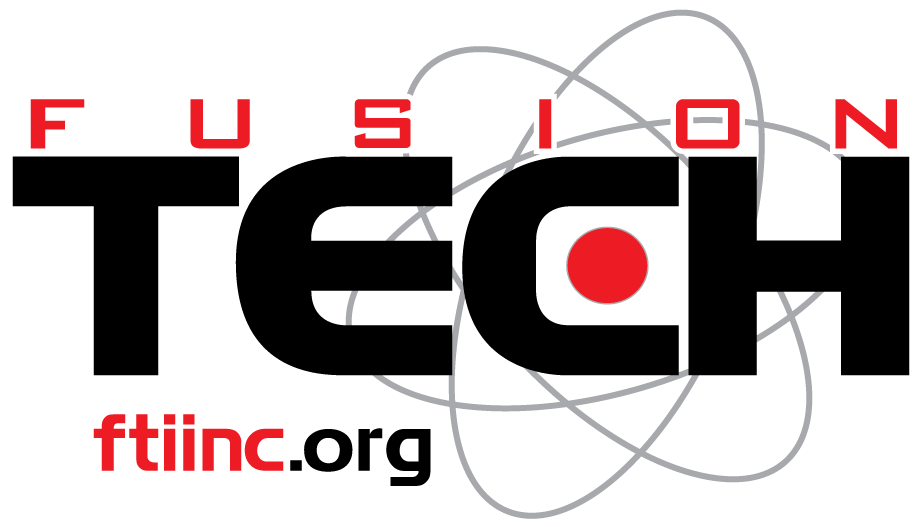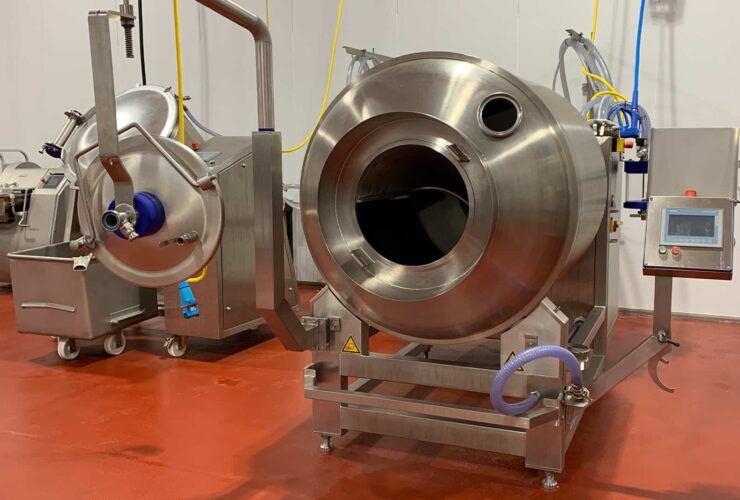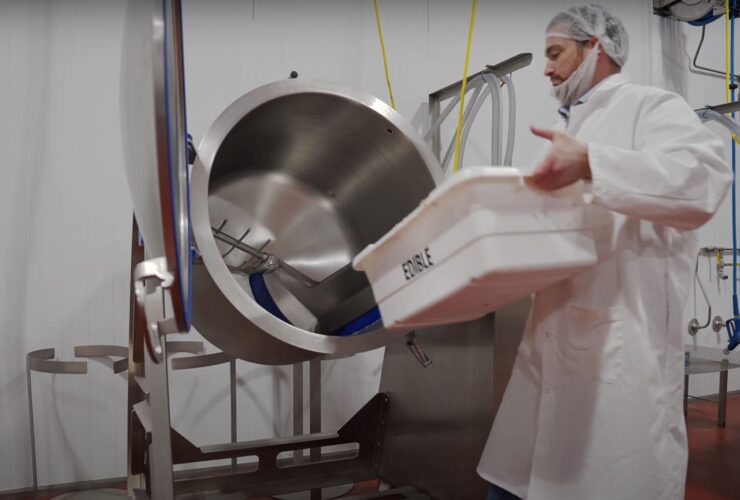Vacuum tumblers are an essential tool for many food processors and are used to coat and/or infuse protein products with functional and sensory-enhancing ingredients.
Their ability to achieve this task quickly and efficiently makes vacuum tumblers staple pieces of equipment in most food processing plants.
Even with the essential role they play, very few innovations have occurred in the design and manufacture of vacuum tumblers in the last 50 years.
Most manufacturers stick to a few basic designs that have been used for decades.
In order to innovate how proteins are tumbled, a change to the design of vacuum tumblers is needed.
How does Vacuum Tumbling Work?
Before we dive into design, it’s important to know how vacuum tumbling actually works.
Vacuum tumbling refers to the process of putting a substrate (protein in this context) in a high vacuum environment while turning the drum, thereby causing the substrate to “tumble” within the vessel.
The act of putting the product under a vacuum “opens up” the structure of the protein providing physical space within the product for the ingredients to fill. The tumbling motion helps move these ingredients deeper into the product.
Think of it as applying lotion to your hands — the vacuum opens the pours in your skin and the rubbing motion of your hands facilitates the movement of the ingredients (lotion) into your skin.
This process allows the brine or marinade to achieve deeper and more consistent penetration. This also happens at a much faster rate than simply soaking the protein in a solution.
Historic Vacuum Tumbler Design
Generally, historic tumbler designs rely on a rotating drum with some series of “fins” that lift and fold the product as the drum rotates.
Many manufacturers also offer a version where hydraulic cylinders tilt the drum back and forth while it is turning, in an attempt to improve batch consistency and eliminate the variances that can be seen in products tumbled in the same batch.
These in-batch and batch-to-batch variances can be attributed to the fact that the products’ relative position within the tumbler can affect how much or how little the product is tumbled or massaged.
By tilting the tumbler, they can change the environment in the tumbler in an attempt to work all of the products equally.
While these solutions have proved useful, they are also costly to build, purchase, and maintain.
They can also present additional safety concerns due to the potential pinch points associated with pivoting the large vessels.
Is there not a way to achieve better yields, consistency, and product quality in the marination process in a more cost-effective way through a more simple design?
We think there is — and it requires a unique diagonal fin design.
Type of Fins in a Vacuum Tumbler
Most vacuum tumblers contain straight fins within the drum — meaning the fins generally follow the long axis of the drum.
This style of fin causes meat to simply tumble or drop from the fin to the bottom of the drum in a singular motion and doesn’t provide a means to move the product at the back of the drum to the front and vice-versa.
Contrast that to a diagonal fin, as shown below.
A diagonal fin is just as it sounds: it runs diagonally through the drum, instead of straight across.
This style of fin causes meat to not only tumble or drop from the fin to the bottom of the drum but also moves the product from the front to the back, and vice versa.
Why Do Diagonal Fins Matter?
The secondary motion caused by diagonal fins — that front-to-back motion mentioned above — has a profound impact on the marination process.
3D Tumbling
Diagonal fins allow you to achieve what we call 3D tumbling.
That movement of product from the front to the back of the drum (and vice versa) creates a more complete tumble. Product isn’t just falling on top of one another. It’s also moving end to end.
This 3D tumbling provides an environment where every piece of product in the batch is worked in a very consistent manner.
Increase Protein Activation
Another benefit of this 3D tumbling comes in the form of increased protein activation and extraction in a shorter period of time.
Simply put, protein activation is where the myofibrillar proteins in meat are broken down through the application of functional ingredients and the mechanical action produced by the tumbler.
The breakdown of some of the myofibrillar proteins can improve tenderness, impact the texture, and improves yields by helping to “lock” your ingredients into the matrix of your product — meaning you achieve a much higher yield, with improved quality and consistency.
Vacuum Tumbler with Diagonal Fins
Diagonal fins are not the industry standard in vacuum tumblers.
Henneken’s Type B Vacuum Tumblers are the only tumblers on the market to have perfected the diagonal fin design.
Through careful calculations and extensive testing, the Type B vacuum tumbler achieves all the benefits listed above.
Learn more about the Henneken Type B Vacuum Tumbler or book a time to talk to our marination specialist.







